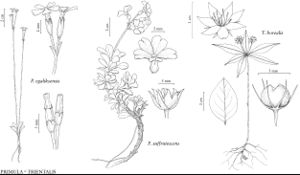Trientalis
Sp. Pl. 1: 344. 1753.
Gen. Pl. ed. 5, 161. 1754 ,.
| Taxon | Illustrator ⠉ | |
|---|---|---|
 | Primula egaliksensis Primula suffrutescens Trientalis Trientalis borealis | Barbara Alongi Barbara Alongi Yevonn Wilson-Ramsey Yevonn Wilson-Ramsey |
Herbs, perennial, not succulent, glabrous or glandular; resin canals rarely obvious. Rhizomes slender or tuberous; roots fibrous. Stems erect, usually simple. Leaves in terminal whorl or cluster, dimorphic, with smaller cauline and alternate ones proximally (some ± scalelike); petiole present (distal) or absent (proximal); blade lanceolate or oblanceolate to elliptic, suborbiculate, obovate, or spatulate, base cuneate, margins entire, plane, apex acuminate, acute, or obtuse to rounded, surfaces glabrous. Inflorescences axillary in distal leaves, solitary flowers. Pedicels present. Flowers: sepals (5–) 7 (–9), green, calyx lobes lanceolate or lanceolate-linear, much longer than tube; petals (5–) 7 (–9), corolla white to pink, rose, or pinkish lavender, rotate, lobes longer than tube, apex acute or acuminate; stamens (5–) 7 (–9); filaments connate basally. Fruits capsular, globose, dehiscence valvate. Seeds 2–15, black or reddish-brown, globose, with deciduous, white, netlike covering. x = 35, 42.
Distribution
n North America, Eurasia
Discussion
Species 3 (3 in the flora).
The number of species recognized in treatments of Trientalis has varied from two to four; in some, only T. europaea and T. borealis have been recognized, sometimes T. latifolia has also been recognized, while other authors have segregated the northern Pacific populations of T. europaea as T. arctica. We consider only three to be solid species.
Selected References
None.
Lower Taxa
Key
| 1 | Flowering pedicels usually longer than leaves; proximal leaves gradually smaller than terminal cluster, at least some wider than 1 mm; distal leaves widest beyond midlength. | Trientalis europaea |
| 1 | Flowering pedicels usually shorter than leaves; proximal leaves abruptly much smaller than terminal cluster, all 1.5 mm or narrower; distal leaves widest at or below midlength | > 2 |
| 2 | Corollas white; leaf blades lanceolate to lanceolate-elliptic, apex acute to acuminate; pedicels 1-3 (rarely more). | Trientalis borealis |
| 2 | Corollas pink, rose, or pinkish lavender; leaf blades elliptic to suborbiculate (narrower in some plants along Vancouver Island and Washington coast), apex rounded to acute; pedicels 1-5. | Trientalis latifolia |